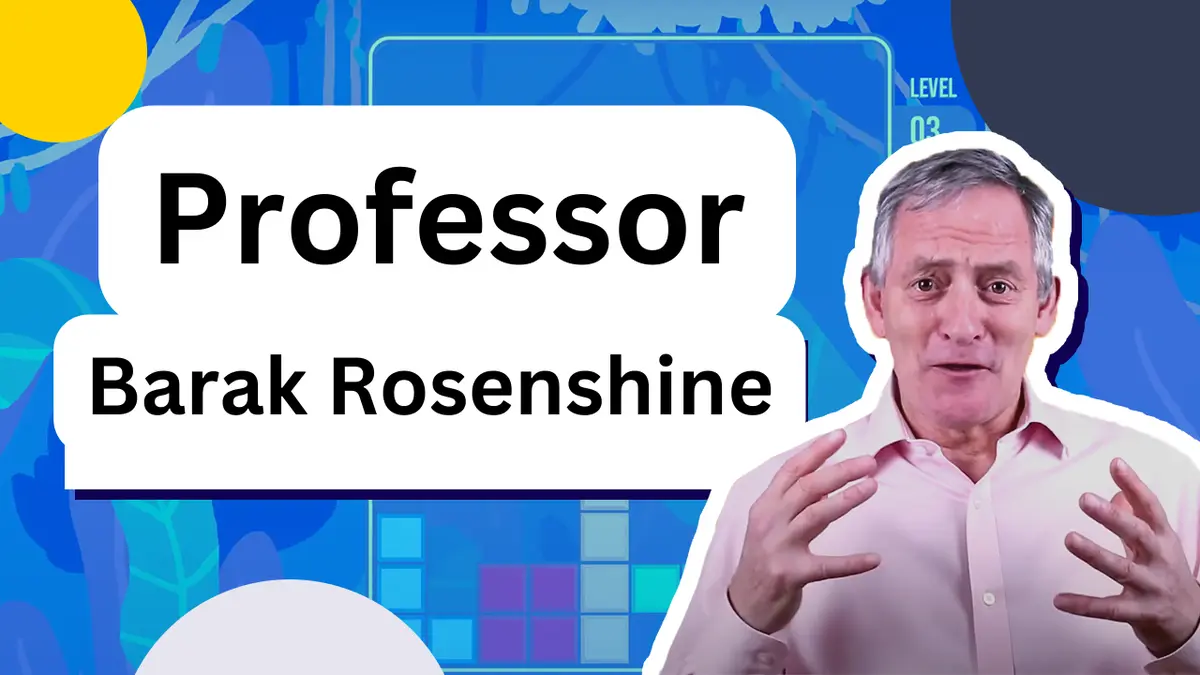10 Principles Of Instruction Professor Barak Rosenshine
The educational community has grown to rely more and more on Rosenshine’s Principles Of Instruction since they offer practical yet well-known teaching techniques that can improve student learning. A much-needed link between scientific research and classroom methods is made possible by these ten principles.
Introduction Of Professor Barak Rosenshine
Professor of educational psychology at the University of Illinois College of Education, Barack Rosenshine was an educational psychologist. Before receiving his PhD in educational psychology from Stanford University, he had a career as a high school history teacher.
His studies mostly concentrated on identifying the traits of good instruction by examining the connection between student accomplishment, instructor effectiveness, and direct instruction.
- Rosenshine’s idea integrated classroom observations with his decades of cognitive science research to coursework help instructors gain a deeper knowledge of:
- How to apply classroom tactics in an efficient manner;
- Ways to aid students in absorbing and recalling new information in class;
- The extent to which educators ought to assist their students.
The 10 Principles Of Instruction By Professor Barak Rosenshine
Professor Barak Rosenshine first put up 17 guidelines that, in his opinion, were essential to good instruction and learning. In order to give educators more clarity, he condensed this list into 10 essential principles in 2012. So, those ten principles of instruction by Barak Rosenshine are given below:
First Instructional Principle: Conduct a daily review
Rosenshine stressed the value of starting a class with a review of prior knowledge in his first principle. Students should be able to draw connections between concepts and have a deeper comprehension of the class material by spending a brief period of time reviewing and assessing prior knowledge. Students will consequently achieve better academically. Rosenshine suggested that instructors devote five to eight minutes of each class to a daily review.
The Reason Of Research
Studies indicate that learners who consistently engage in retrieval practice have a higher likelihood of retaining academic content, especially in high-stress situations.
According to one study, students were not aware of the advantages of retrieval practice for memory, even if it was successful at transferring knowledge to the long-term memory store. Rather, the students reported that they were able to produce feedback or knowledge regarding the state of their learning through retrieval practice.
Second Instructional Principle: Introduce new content gradually
The focus of Rosenshine’s second premise is on solving our working memory’s primary drawback, its short size. Rosenshine recommended that material be provided to students in manageable, successive steps to online exam helper prevent teachers from overburdening their cognitive load. Additionally, it helps make difficult work seem more doable.
The Reason Behind Research
It is vital for educators to guarantee that all content is presented uniformly. This is because a student’s working memory may get overloaded when they receive information from two or more sources. Students lose energy and resources by having to continually switch between sources, which has a detrimental impact on their academic performance.
Third Instructional Principle: Make a lot of thoughtful inquiries
Rosenshine lists using questions as one of a teacher’s most effective tools and suggests that teachers use them more in the classroom as his third principle. One of the simplest methods to support students’ retrieval practice in the classroom and help them commit their entire learning to long-term memory is to ask questions.
The Reason Behind Research
According to a study, students who received a lot of questions from their teachers during instructional training outperformed those whose teachers only asked nine questions during the entire lesson. But they shouldn’t be any old questions; rather, they should be a variety of factual recall questions.
Fourth Instructional Principle: Give examples
According to Rosenshine’s fourth principle, teachers should model their own thinking and demonstrate actions to students when introducing them to new and complex information in order to minimise the possibility of confusion and blunders. Rosenshine examines modelling as a type of scaffolding in his eighth principle since it provides students with visual examples to aid in their learning.
The Reason Behind Research
Studies reveal that students who had teachers who modelled their cognitive processes for them in the classroom not only do better academically but also tend to stay on task and not put off solving problems when they don’t know the answer.
Fifth Instructional Principle: Direct student practice
As his fifth principle of instruction, Rosenshine suggested that educators devote more time to helping students practise so they can deepen their comprehension in a setting where they can ask for assistance if they run into trouble. This can be accomplished by:
- Rewording
- Recapitulating
- Assessing
- Providing Details
- Utilising recently acquired knowledge
Sixth Instructional Principle: Verify that students have understood
Rosenshine’s sixth principle of instruction focused on the significance of routinely evaluating students’ comprehension to catch any misconceptions or misunderstandings early on and prevent them from influencing subsequent learning and leading to mistakes. By assessing students’ comprehension, teachers can ascertain whether they require additional time to reteach material and gauge the extent of their understanding.
Getting this one correctly will help you apply the other nine Principles of Instruction by far, making it the most significant of Rosenshine’s Principles of Instruction.
The seventh instruction principle is to achieve a high success rate.
Rosenshine proposes that teachers should have high student success rates in the classroom as his seventh principle. Teachers should aim for an 80% success rate in particular, which indicates that students are being challenged in their comprehension, but not to the point where they are not learning anything. Students gain self-assurance and willingness to work as a result.
Eighth Instructional Principle: On the contrary, provide the learners with risky situations and scaffold the task assignments.
Rosenshine’s eighth principle of teaching argues that the teacher should act only as the students’ temporary helpers in fulfilling the role that the latter need to assume effectively in the course of learning activities.
Scaffolding is about gradually withdrawing the support you provide to students after they get increasingly confident in their capacity to complete a work efficiently and within the stipulated time. The children who benefit from this kind of coaching gain effective strategies in handling their study assignments and grasp complicated concepts in an expeditious manner.
The ninth instruction principle is to mandate and oversee independent practice.
According to Rosenshine’s tenth principle, educators should make sure that students are practicing independently and keep an eye on them until they gain the confidence and independence to learn on their own. This is the process of repeatedly practicing an activity on their own (also known as “overlearning”) in order to reduce the amount of time it occupies their working memory. Students can now focus on ingraining fresh course material into their long-term memory.
Tenth Instructional Principle: Have weekly and monthly reviews with students
As an extension of his first principle of instruction, Rosenshine’s tenth highlights the value of motivating students to participate in weekly and monthly evaluations of the material they have just learned. This is due to the fact that routine information review improves pupils’ learning through:
- Establishing links between their previous and current knowledge;
- Allowing their working mind to have more room;
- Ensuring that students have a solid factual foundation for their future education;
- Improving the recall of memories.







